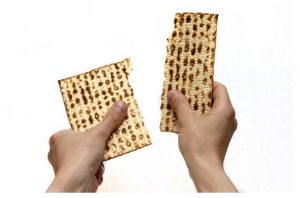It is Passover, a Jewish holiday with so many meanings and also designed around questions. On this Easter Sunday in the middle of Passover which itself is in the middle of Ramadan, I wish all who celebrate a Happy Easter, a Chag Sameachand/or Moadim L’Simcha, and a Ramadan Mubarak. May your happiness and joy come from the celebrations and from finding yourself in your tradition and its stories!

For Jews, finding oneself in the Passover tradition is about more than feeling included in the holiday rituals, it is the fulfillment of a commandment. Exodus 13:8 says, “You shall tell your child on that day itself, saying, “It is because of this that God did for me in my going out of Egypt.’” So many of the rituals help in telling our children the story: symbolic foods, songs, and all manner of unusual ways of doing things that all prompt questions. The harder part is our own place in the story, not just the rituals.
Jewish tradition had two easy answers in the time of the Second Temple. For one, Jews would make an actual pilgrimage to make and eat the paschal offering. The other answer used pilgrimage from another festival to make telling the story easy. Verses recited at Shavuot (Deuteronomy 26:5-9), likely repeated word-by-word responsively, became the core of the Passover seder and later the Haggadah (Passover guidebook). That passage has the added bonus of having a catchy opening that reads, “arami ‘oved avi” each word starting with aleph. Everett Fox translates the opening, “An Aramean Astray my Ancestor,” though there has been significant debate about the meaning of the words for thousands of years. A familiar phrase, easy to remember, and open to interpretation is a wide-open point of entry into personal meaning-making.
That point of entry, though, is not at all familiar to more and more Jews. Something else needs to be the hook. This year, I will be offering these themes as calls to find ourselves in the story: spring renewal (often coming with tears) when we dip parsley in salt water; how do we respond to brokenness in the world and in our lives when we break the middle matzah, marking both the bread of affliction and the afikomen (the piece of matzah that concludes dessert); what are we emotionally or spiritually hungry for as we lift the matzah; the struggle for freedom from tyranny; living in the face of hatred; crying out to a seemingly absent God; and naming that which plagues our world today. These themes come from moments the seder carves out to find ourselves personally, politically, or spiritually.
What unites these themes is the desire for transformation of ourselves or of the world we live in. While the ideal is to tell the story with the joy of achievement at having reached the other side, my goal this year is less of a high and more of an enduring happiness that comes from knowing we matter wherever we are on the journey. The Jewish story, yes, is a story of a people; and it is a story of individual people who find the connection between themselves and that bigger story. So, what is the hook for us today? It is to ask ourselves the question: where am I in this ritual? Asking that question is the key to enacting and to activating the ritual so that we emerge as storytellers who belong in the story, now and into the future.
About Rabbi Jeremy Winaker
Rabbi Jeremy Winaker is the executive director of the Greater Philadelphia Hillel Network, responsible for West Chester University, Haverford, Bryn Mawr, and other area colleges. He is the former head of school at the Albert Einstein Academy in Wilmington and was the senior Jewish educator at the Kristol Hillel Center at the University of Delaware for four years. Rabbi Winaker lives in Delaware with his wife and three children.

Comments